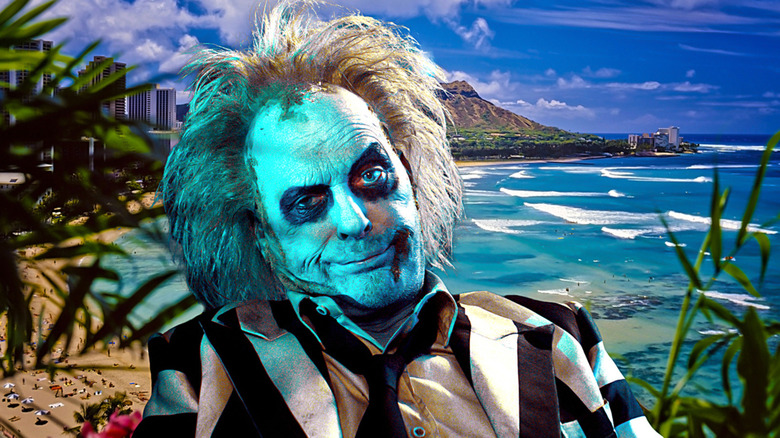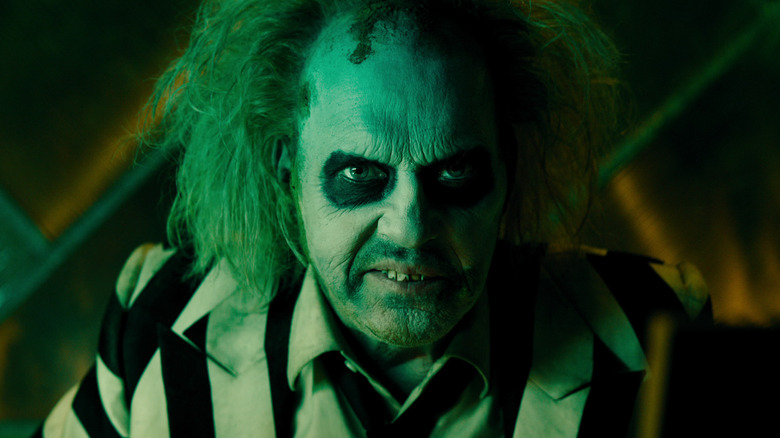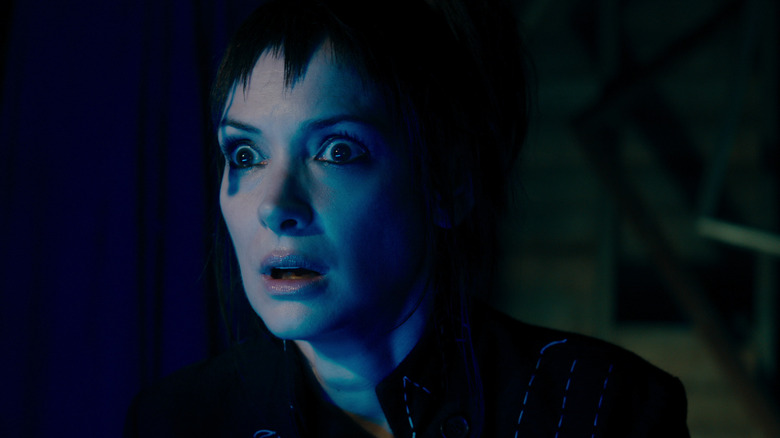Tim Burton's Beetlejuice 2 Almost Sent Michael Keaton's Ghost With The Most To Hawaii
Tim Burton's new film "Beetlejuice Beetlejuice" has made over $153 million to date, which is surprising for a 34-years-after-the-fact sequel to an eerie, unusual comedy about unhappy rural ghosts (Alec Baldwin and Geena Davis) and the randy demon (Michael Keaton) they hire as a professional haunter. Keaton, Winona Ryder, and Catherine O'Hara return from the original film, now 34 years older and at new places in their lives. It seems that Betelgeuse still has randy, wedding-forward machinations at hand.
It's unusual that "Beetlejuice Beetlejuice" finally got made, seeing as how several "Beetlejuice" projects had deflated in the past. Back in 1988, when "Beetlejuice" became a hit, two "Beetlejuice" sequels were immediately commissioned, and Hollywood was abuzz with where a follow-up might go. One of the original ideas was to be called "Beetlejuice in Love," written by Warren Skaaren, one of the first film's most active script doctors. That never-made film was to follow Betelgeuse as he escapes the land of the dead to pursue a living woman whose fiancée just died. That script was quickly dropped, however.
The other script, written by Jonathan Gems at Tim Burton's personal request, was the wackier idea, and news of its making quickly reached the public, instigating bemused chuckles. It was to be called "Beetlejuice Goes Hawaiian," and it would take everyone's favorite deceased Lothario out into the Pacific for a tropical vacation. The idea was bizarre enough to draw attention, and it seemed for a few golden moments — sometime in 1990 — that "Hawaiian" might actually be made. Burton's cache had only grown after he made "Batman" in 1989, and "Beetlejuice" stayed tangentially in the consciousness with a 1989 animated TV series adaptation. Also, Michael Keaton and Winona Ryder had agreed to return, and Burton was keen to direct.
The story wasn't bad, either. Jonathan Gems described the movie in a 1997 interview with Fangoria Magazine.
Beetlejuice Goes Hawaiian
In "Beetlejuice Goes Hawaiian," the Deetzes would move to Hawaii so that patriarch Charles (Jeffrey Jones) can open his very own beach resort. It was established in the first "Beetlejuice" that Charles had recently suffered some kind of nervous breakdown while living in the big city, requiring his relocation to a quaint home in the country. He loved birdwatching, and needed to be in a constant state of relaxation. The idea of moving him to a tropical beach is perfectly logical.
As it so happens, however, the site of the Deetz resort is the burial ground of an ancient Polynesian Kahuna. The groundbreaking disturbs the Kahuna's gravesite and his ghost returns, full of otherworldly wrath. Betelgeuse would have to be summoned to match wits with the Kahuna and drive him back into the afterlife. The film would climax in a surfing competition, which Betelgeuse would win with his own ghostly magic. Gems noted Burton's enthusiasm for the project specifically because it sounded so ridiculous. Burton wanted to push his signature Gothic aesthetic into a 1950s beach party picture, causing a deliberate visual clash. "Tim thought it would be funny," Gems said, to match the surfing backdrop of a beach movie with some sort of German Expressionism, because they're totally wrong together."
One can read Gems' "Beetlejuice Goes Hawaiian" script online, and explore the additional character wrinkles the screenwriter came up with. Gems invented a character named Rita, Betelgeuse's wife, whom he hates and bickers with. One might recall a gag from the 1988 film wherein Betelgeuse extracts a severed finger from a coat pocket, only to steal a ring still on it. That was to be Rita's finger. After the events of the first film, Betelgeuse would have to give up his below-the-board job as a bio-exorcist and take a job in an eerie, afterlife supermarket. Things aren't too rosy for him. A beach getaway is just what he needs.
Other things in Beetlejuice Goes Hawaiian
For "Beetlejuice Beetlejuice," Rita was replaced by a character named Dolores (Monica Bellucci), Betelgeuse's spurned, sliced-up ex-lover who actually murdered him hundreds of years ago. Some of the ideas from "Hawaiian" remained.
But Hawai'i? It's actually not so strange. It's worth remembering that the music of Harry Belafonte plays a big role in the first "Beetlejuice," and that movie ends with Lydia, Ryder's character, magically lip-synching to "Jump in the Line." The film is kooky and Gothic, but is not without a sunny sensibility. Replacing Trinidadian calypso with early-'60s surf rock isn't so big a cognitive stretch. Also, Lydia was utterly alone in the first "Beetlejuice," but become smitten with a surfer boy named Kimo in Jonathan Gems' script. He'll end up protesting the Deetz's resort and, later, kidnapping Charles.
Other antics include a scene wherein Betelgeuse transforms himself and Lydia into mermaids, and another scene wherein he creates a flirty bikini babe to distract Kimo. Lydia travels into the afterlife to talk to Betelgeuse, and there is a subplot with a love potion. Betelgeuse will try to marry Lydia, but the marriage was to be interrupted by Betelgeuse's mother. There is no indication in the script as to who might play that character.
"Beetlejuice Goes Hawaiian" fell apart because Burton became too busy with other projects. During its writing, Burton made "Edward Scissorhands," and then immediately jumped into production on "Batman Returns," which also required Michael Keaton. Ryder was also busy with "Scissorhands," but also notable films like "Mermaids," "Night on Earth," and "Bram Stoker's Dracula." Other blockbusters simply got in the way.
"Hawaiian" was put in a drawer long ago, and the project eventually mutated into the sequel currently playing in theaters. Some might lament the loss of an undead beach party movie. Others may be happy with what we got.


